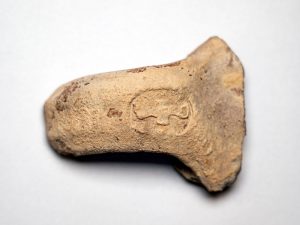Uma estrutura administrativa de armazenamento da época dos reis Ezequias (716/15-699/8 a.C.) e Manassés (698-643/2 a.C.), de Judá, foi descoberta perto da antiga Jerusalém e está sendo escavada por arqueólogos da Autoridade de Antiguidades de Israel (IAA).
Os pesquisadores descobriram uma grande estrutura, feita de paredes de pedra que se acredita terem sido usadas para atividades governamentais. Lá, eles descobriram 120 alças de jarros, marcadas por impressões de selos em hebraico. Muitas das alças têm “LMLK” – que significa “pertencente ao rei” – inscritas nelas. Os arqueólogos acreditam que o local tenha sido usado pelo governo judaíta para coletar impostos, gerenciar e distribuir alimentos.
A estrutura pode ser da época da invasão de Senaquerib, rei da Assíria, nos dias do rei Ezequias, em 701 a.C. Talvez as disposições econômicas do governo indicadas pelos selos estejam relacionadas a esses eventos. No entanto, a escavação revela que o local continuou ativo após a invasão assíria, dizem Neria Sapir e Nathan Ben-Ari, diretores das escavações.
As impressões dos selos apontam para a possibilidade de que a atividade governamental tenha funcionado até os últimos anos do reino de Judá. Abandonado durante o exílio babilônico (586-538 a.C.), parece que o local foi reativado e a atividade administrativa retomada na época persa, a partir de 538 a.C.
Leia mais sobre a descoberta, em inglês.
Huge Kingdom of Judah government complex found near US Embassy in Jerusalem – By Amanda Borschel – The Times of Israel: 22 July 2020
One of the largest collections of royal Kingdom of Judah seal impressions has been uncovered at a massive First Temple-period public tax collection and storage complex being excavated near the new United States Embassy in Jerusalem. The main Iron Age structure is exceptional in terms of both its size and architectural style, said Israel Antiquities Authority archaeologist Neri Sapir, who co-directed the excavation.
Uncovered only three kilometers (1.8 mile) outside the Old City, the compound is believed by Israel Antiquities Authority archaeologists to have served as an administrative center during the reigns of Judean kings Hezekiah and Manasseh (8th century to the middle of the 7th century BCE).
One of the largest collections of royal Kingdom of Judah seal impressions has been uncovered at a massive First Temple-period public tax collection and storage complex being excavated near the new United States Embassy in Jerusalem. The main Iron Age structure is exceptional in terms of both its size and architectural style, said Israel Antiquities Authority archaeologist Neri Sapir, who co-directed the excavation.
Uncovered only three kilometers (1.8 mile) outside the Old City, the compound is believed by Israel Antiquities Authority archaeologists to have served as an administrative center during the reigns of Judean kings Hezekiah and Menashe (8th century to the middle of the 7th century BCE).
Over 120 jar handles stamped 2,700 years ago with ancient Hebrew script seal impressions were discovered at the site, clearly indicating the location’s use as a storage
and tax center, according to an IAA press release Wednesday. Prevalent among the stamped inscriptions is “LMLK,” “LamMeLeKh,” or “Belonging to the King,” a way of marking that the foodstuffs stored in the jars had been tithed to the Judean ruler.
This trove of LMLK seal impressions adds to the over 2,000 similar seals previously discovered at excavations and allows archaeologists to rethink the administrative and tax collection systems of the Kingdom of Judah…
Storage Center of Prominent Kings of Judah Uncovered in Jerusalem – Bridges for Peace: July 23, 2020
A significant administrative storage center from the days of Kings Hezekiah and Menashe (8th century to the middle of the 7th century BC) has recently been exposed at archeological excavations in the Arnona neighborhood of Jerusalem. The excavation conducted by the Israel Antiquities Authority (IAA) [near the] US Embassy is funded by the Israel Land Authority and administrated by the Moriah Jerusalem Development Corporation for the development of a new neighborhood.
Excavation at the site revealed an unusually large structure built of concentric ashlars walls. Of particular interest, 120 jar handles were found bearing seal impressions containing ancient Hebrew script. Many of the handles bare the inscription “LMLK”—(belonging) to the King—with the name of an ancient city, while others feature the names of senior officials or wealthy individuals from the First Temple period. This is one of the largest and most important collections of seal impressions ever uncovered in archaeological excavations in Israel…

